
18 minute read
LET’S TALK ABOUT TOILETS

Advertisement
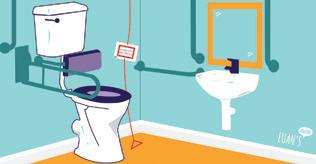
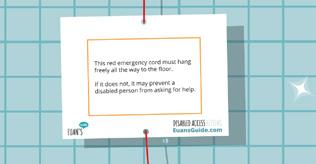
The latest instalment from disabled access review site Euan’s Guide, highlights the importance of Red Cord Cards and Changing Places facilities
At Euan’s Guide we talk about toilets quite regularly. Firstly, whether or not somewhere had an accessible or Changing Places toilet. Then, if it did have one, what it was like and what we would change about it.
Toilets are an important part of the disabled access reviews left on EuansGuide.com, and we always love it when reviewers or venues share photos of the loos with us. That’s because everyone’s access requirements are different, so while you might be looking for right hand transfer, someone else might be looking for a shelf, turning space or high contrast to help identify the fittings. It is true what they say, a picture is worth a thousand words, and a picture of an accessible loo can quickly give people the information they need to be able to decide whether or not they’d be able to use the toilet.
So often venues are let down by their accessible toilet (or a lack of one). Have you ever come across an accessible toilet with a broken grab rail or toilet seat? How about one that doesn’t look like it has been cleaned lately? Gross! Or what about one that is also being used as a storage cupboard? Sigh.
How handy would it be to know about these issues before you visited and how easy would it be for venues to fix these problems? One common problem we kept hearing about in people’s reviews was red emergency cords that wouldn’t be of any use in an emergency because they were cut too short or tied up out of reach. These emergency cords are designed so that they could be used by someone sitting on the toilet or lying on the floor who needs to raise the alarm to call for assistance. The problem is that far too many people don’t know what the cord is there for, which is why we designed Red Cord Cards. Our Red Cord Cards are splash-proof cards designed to be attached to all red emergency cords to remind everyone that the cord should be left hanging freely so that it could be used in an emergency. The sign is an important tool to alert all toilet users, cleaners and staff to leave correctly positioned cords as they are and can help signal to venues when the cord needs to be fixed. Individuals can request free Red Cord Cards from us by visiting EuansGuide.com/redcord. Their size makes them

easy to carry around so that they can be added to every red emergency cord that you see. Thanks to the help of thousands of people across the UK we’ve already given out over 60,000 Red Cord Cards to help make so many accessible toilets safer. We don’t want to stop there either, we’d love to see Red Cord Cards in every accessible toilet. Visit our website if you’d like to support us and help make this dream a reality.
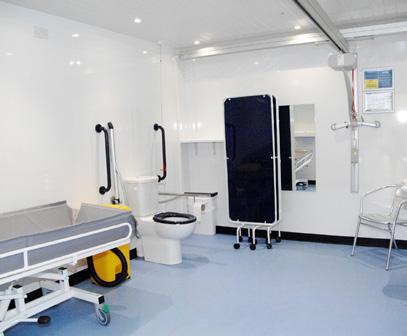
Something else that’s a big toilet let down is the lack of Changing Places toilets. We’re a big fan of Changing Places here at Euan’s Guide. A Changing Places toilet includes a height-adjustable changing bench, a ceiling hoist; a peninsular toilet and a privacy screen. There also needs to be space for the toilet user and up to two carers. These toilets do not replace accessible toilets but should be provided in addition to accessible toilets. For years the Changing Places Consortium has campaigned for more Changing Places toilets to be provided in all public places, including city centres, shopping centres, railway stations, airports and leisure complexes. There are now just over 1,500 Changing Places registered, yet 250,000 people in the UK require access to the facilities found within a Changing Places toilet to be able to go to the toilet safely when they are out and about. Clearly there is still a need for more Changing Places. More Changing Places will mean that everyone will have more options for great places to visit. To find out how you can support the Changing Places campaign visit Changing-Places.org
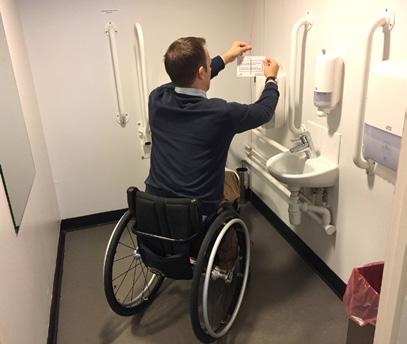

In the meantime, we’d love it if you could help us shout about the places you find accessible and where they have accessible or Changing Places toilets that you can use by reviewing them on Euan’s Guide. Reviews are a great way to share your experience and recommend those places that you enjoyed visiting. Knowing another disabled person enjoyed their visit is really helpful when planning a trip.

As well as being a place where you can share your recommendations with other disabled people, leaving reviews on Euan’s Guide can also be a powerful tool for change. Did a bad accessible loo or lack of Changing Places let the experience down? Mention it in your review! We’re proud to say that we share new reviews with venues, and we know that the feedback people leave on Euan’s Guide can lead to venues taking action and make changes to improve their accessibility.

If like us, you don’t mind a bit of toilet talk you might want to join our Facebook group where we discuss toilets and share our Red Cord Card adventures. You can find the group by searching ‘Red Cord Cards by Euan’s Guide’ on Facebook. Or visit EuansGuide.com/ toilets to find more ways to get involved.
Kids’ CORNER
The year is drawing to a close. The days are getting shorter, the nights longer, and the weather colder. Winter, as they say, is coming. Ordinarily, this is when our little ones would begin chattering with excitement over Halloween, wondering what they can dress up as, and getting excited over miniature chocolate bars. Everything is different in 2020, however, and a traditional Halloween seems as likely to happen this year as turning lead into gold. This is a perfect time, however, to make your own traditions, in your own home, and with your own family. Turn to page 52 for some ideas from Team Pos on how to keep the spooky spirit alive this year.
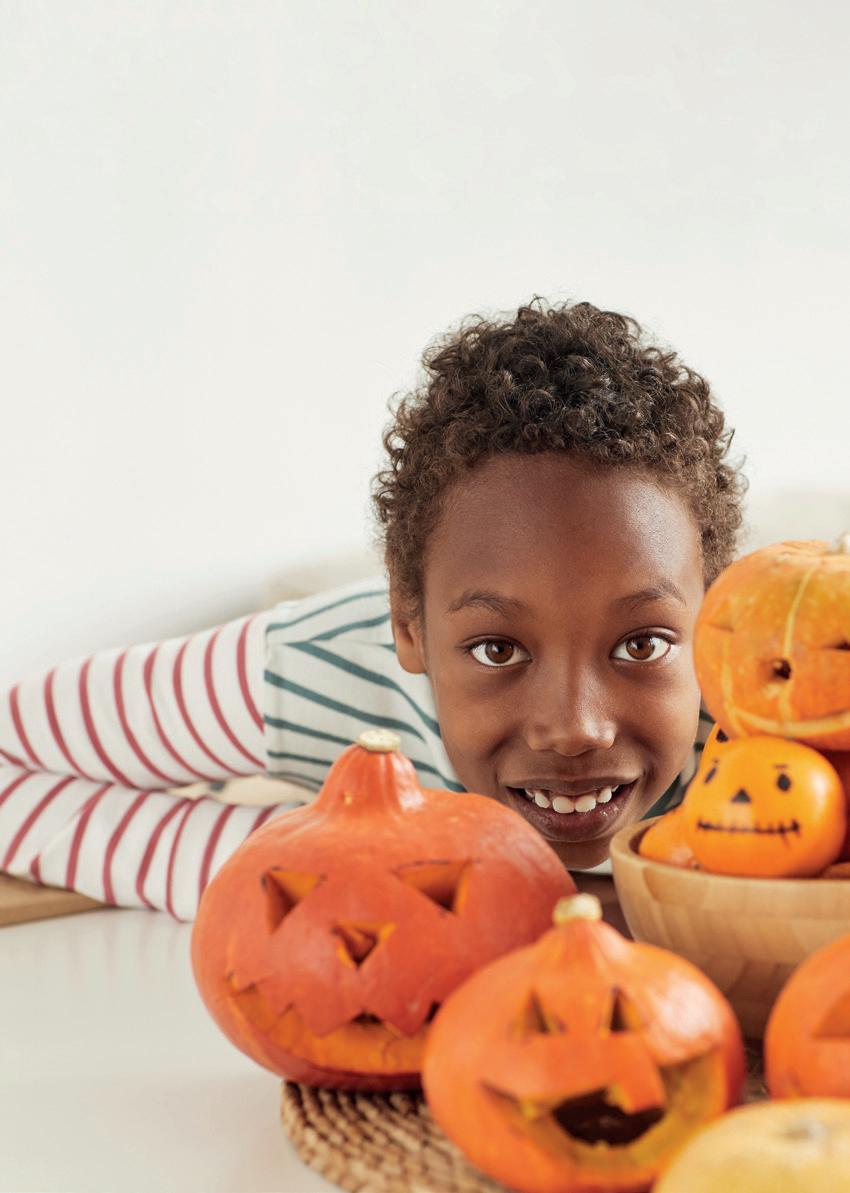
As usual, we have our great selection of kids’ products and regular columnist Dan White, alongside this issue’s fantastic Future Voices contributor, Zan Godden, who explores their feelings of not being “disabled enough” within the disabled community. If you have anything you would like to see featured in the magazine, please don’t hesitate to email it over to ros@2apublishing.co.uk.
PRODUCTS
pg 54
Haunting AT HOME
BY KATIE CAMPBELL

We can’t take to the streets for some trick or treating this year, but never fear: Halloween can never be cancelled. We wouldn’t allow it
For a heartbreaking six months, the goths, costume fanatics, and lovers of the macabre amongst us have had to come to terms with one single, tragic fact: in the year 2020, Halloween will have to exist only in our dark hearts. From the Bauhaus fanatic who dresses as
Siouxsie Sioux six days out of seven each week (resting only on a Sunday to let their skin breathe outside of constant heavy foundation use), to the parent quickly wrapping their child in toilet roll in the face of a school costume day panic; we know and understand that this year, Halloween will be an inside sport. (WITCH)CRAFTS Can we truly deem a Halloween “spooktacular” if it does not have powerfully spooky decorations? In our humble opinion: if you don’t have at least three bats, ravens or cobwebs around your house on 31 October, you are not truly doing Halloween. Decorating your home for one single day sounds expensive, but it doesn’t have to be. It’s a wonderful time to get little spooks and spectres in to make some excellent decorations for your home. Orange and black paper chains are a classic, as are pompom spiders. Remember making paper snowflakes

Halloween is fun for little and big kids: some people engage in spiritual or cultural practices, and some just love getting dressed up as Frankenstein’s monster and collecting as much chocolate as they can get their hands on. With the looming presence of coronavirus around the world, and the presence of a second wave rearing its ugly head in the UK, this will be a year of trying to translate our outdoor Halloween activities into fun indoor ones.
If you’re looking for some fun ideas that can be done from the comfort of your own spooky home this year, fear not: the Halloween fanatics at PosAbility have been dreaming up ideas for our very own Halloween Spooktaculars that will have you doing the dance macabre from dusk ’til the

witching hour. at school? Paper cobwebs are the future. If you have any spare tissue paper just lying around - and let’s face it, who doesn’t - you can make some very cute tissue paper ghosts by crumpling one sheet into a ball, wrapping a sheet over the top of it, and fastening it with an elastic band. Draw on some spooky facial features and hey presto - you have your very own Casper the Friendly Ghost! If these ideas are piquing your interest, head to Pinterest, type the word “Halloween,” and get ready to blow your wages on an order of craft supplies from Hobbycraft.
CARVE OUT A NICHE


Pumpkin carving is as American as apple pie, but the origins of the jack-o’-lantern are a lot closer to home than we know. The tradition was thought to have begun in parts of Ireland and the Scottish Highlands, where turnips were hollowed out and carved with strange faces as a means to ward off spirits who would mean them harm, as Halloween was said to be the day where the aos sí or daoine sìth - the spirits and fairies of the land - could most easily cross from the Otherworld and into ours. We’d recommend you carve a pumpkin, though, because they’re larger (and therefore easier to carve), and you can make the innards into pumpkin pie afterwards.


BAKE THE DEAD
For some, a Halloween treat is a mini Mars bar and a handful of monkey nuts. For others, it’s a luminous orange Halloween-themed cake from Greggs, topped off with a ring in the shape of a ghost that you can surreptitiously lick for hours afterwards. Both are very iconic spooky moments. With the lack of trick or treating, however, monkey nuts may be thin on the ground, and a trips to Greggs might be out of the question. At the beginning of the lockdown, everyone decided this was their chance to refine their baking skills: it is time to reawaken those feelings. Get the oven pre-heated and decide whether this will be the year of the witch cupcake, the pumpkin cake pop, or the blood-filled raspberry jam doughnut. One of the most fun things you can do with children are teach them how to make spiderweb cakes, which sounds very difficult, but is actually just messy fun. If you bake and ice a standard cake (we like a chocolate cake here in the Pos office, but it’s your choice) or some cupcakes, you can then melt down some white marshmallows in the microwave. Wait until they’re lukewarm, then get your spectral assistants to press their fingers together and dip them in the marshmallow. When they take their fingers out and pull them apart, they’ll have spiderwebs that they can pull taught over the cake!
A D A P T I V E C O T T O N ZIG ZAG SLEEPSUIT
Made from 100% pure cotton, this sleepsuit is breathable, and is far less likely to irritate soft skin. Designed with comfort and convenience in mind, the sleepsuit allows for simplified dressing with its poppers, and provides easy access for feeding and medical tubes. Available in sizes for three to 16 years.
marksandspencer.com 0333 014 8000

Prices from £7
D I S A B L E D P E O P L E PLAY FIGURES Representation is vital, and children should have access to toys who look like them, and use the same kind of adaptions that they do. This set features a young man who uses a hearing aid, a wheelchair user, a person with leg braces, and more. They are designed to be used in tandem with the Tuff Tray Play, sold separately.
sensorytoysuk.co.uk 0330 122 4417
H I D D E N DISABILITIES BADGE
Sometimes, people need a little reminder that not all disabilities are visible. A badge is the perfect way to remind them: stylish, discreet, and available in a variety of colours. Buying these badges from The Artful Badger not only helps raise awareness of hidden disabilities, but supports a small local business - win win!
Prices from £2

TheArtfulBadgerUK at etsy.com/uk Prices from £34.99
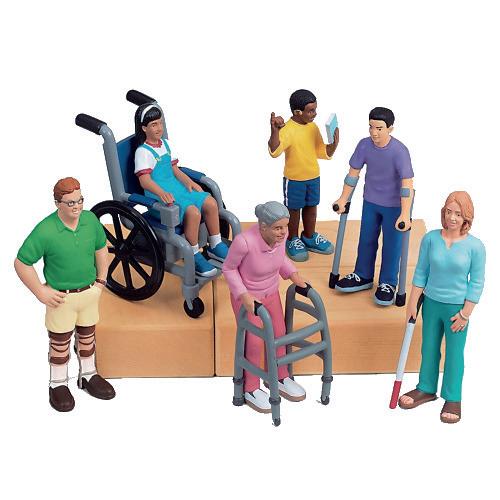
to go up just one floor? Will someone yell at me if I use that toilet? Why am I even asking myself these questions? The idea of being ‘not disabled enough’ is felt by many in our community. It’s a common occurrence for ambulatory wheelchair users to face discrimination if they are seen to get up from their mobility aid, whilst people with invisible disabilities can be interrogated for getting a free carers ticket. I’ve known I was autistic since my early teens; yet I didn’t seek an assessment until I was 18, as I felt I didn’t need additional support to help me through my daily life. In reality, this was because I learned to hide my more overt traits so that I wouldn’t be bullied by my peers. Like many autistic women, I ‘masked’ my disabled self, presenting the world with an acceptable, able-bodied version that could just about cope. I experienced this disability denialism for the first time when I sought my diagnosis for Chronic Fatigue Syndrome. I remember getting my blood taken after finally finding a GP who took my concerns seriously, how excited I was to get an explanation for why I had been struggling, only for the nurse to comment that my fatigue was likely due to “being a busy university student”. However, the whole reason I plucked up the courage to even see a doctor was that I was too inexplicably exhausted to attend my lectures and was terrified of failing my degree. I was being gaslighted, like many of us experience as we navigate ableist societal perceptions of how a disabled person should look and act.

FUTURE VOICES


Each issue we will be shining a light on a young disabled person who is blazing their own trail. Whether that be campaigning for access, giving up their time to help their community, achieving success in the sporting or arts arena, or educating their peers on disability.
For some, these gruelling examinations of our identities can be a matter of life or death. As it currently stands, the process of gaining Universal Credit is deliberately designed to be exclusionary. I know of far too many disabled people dying after they are deemed fit to work, with the Department for Work and Pensions’ ridiculous reasons for rejection ranging from being dressed smartly to walking up the stairs to an assessment unaided.
Unsurprisingly, I do not qualify for any form of Universal Credit, as my symptoms are not as ‘severe’ as the DWP desires. Also unsurprisingly, I am still very much autistic and constantly fatigued, regardless of
ZAN GODDEN
Zan Godden is passionate about disability, mental health and LGBTQ advocacy. If they aren’t in bed with a fatigue spell, you can find them watching drag queen videos or obsessing over comic books. Follow them on Twitter at @ZanSaysStuff.
Can I sit in that priority seat? Should I use the lift
whether the government chooses to pay me. When I am allowed some small ‘perk’ of being disabled, such as a radar key or skipping the queues at a theme park, I have to remind myself that despite the scolding stares from staff or bystanders, I am allowed to have things that make my disabilities that little bit easier to manage. These accommodations are vital to people like me so that we can alleviate (and sometimes altogether avoid) being consumed by an anxiety attack, sensory overload, or fatigue spell.


I may forever have that inner voice telling me that there is always a disabled person more in need of support than I ever will be. And you know what? They’re valid. And so am I. We are all disabled enough, and must continually challenge the stereotypes that prevent us from getting the support we need to thrive.
DAN WHITE
COLUMNIST

Follow Dan on Twitter @DeptOfAbility

Dan White, creator of the amazing Department of Ability superheroes and dad to Emily, who is 12 years old and has spina bifida, is a regular face in PosAbility, as he shares his experiences of life as a family with a disabled child.
A PARENT’S WAR
Parent carers of disabled children are a stoic bunch, a bit like their kids. I should know, I am one. Parent carers more often than not face battles every day for survival that coincides with a routine of care that is unsupported, socially isolated, and financially and mentally destructive.
I want to take this opportunity to show that we do understand what it’s like living with a disability and we do have the right to speak for our children. Solidarity is a fine thing, the disabled community thrives on it. So many incredible diverse voices clamoring for equality and respect, adults and children alike. However, there are a few eyebrows raised when parents like
myself make noise for our children’s rights.
We love our children completely, we want the absolute best for them in this increasingly ableist world. The problem lies not with us shouting out for our children, the problem lies with ineffective care charities, a media still stuck in “victim” mode, and the worry over a future when we, as parents, are no longer around. I’ll elaborate.
There are so many supportive carers charities out there, but a few seem to lack the bite to chew the locks of the system. It is, as a parent, hugely frustrating when a group supposedly having your back, falters and lacks the will to fight on your behalf. You realise that perhaps poking the beast of politics is a step too far for them, that writing meek and softly worded pleas to power is the most we are going to see, when activism and fire is what we want. It falls down to us to snarl, demand and bang the activist table when we have enough to do just surviving.
The media world seems to be stuck in a perpetual formulaic rut with

childhood disability. We know our children will obliterate any stereotypes, however, their progress is held back by the good intentions of shows like Children in Need. We all know the show has been worth its weight in gold from a monetary perspective, but from a storytelling angle, we are still seeing images of sad children accompanied by a grotesque, inappropriate sad piano soundtrack. This all enforces a stereotype. We live with these kids, we see their spirit and know they will ascend to their best, given belief. These images sink into the national psyche and hold our children back, they are not victims, they are children. Children in Need needs an overhaul as its projected view of disabled children is not what we see.
Disability poverty is rife. Parents of all children are concerned about their child’s future, but parents of disabled children are doubly concerned. Access into work, independent living, and care support are wanted for a future that seems, without extensive campaigning, frighteningly unrealistic from today’s standards. Seemingly not a day goes by without a cut to a service they depend on. We live in fear of how the next cut will impact their lives, now and in the future.
We are not politicians, but for a future when we are dust, we have to be political now to secure their prospects. We don’t rage against the machine purposely to drown out our children’s voices or to upset anyone. We often carry mental health issues and hidden disabilities ourselves. We witness attacks from all sides, we just crave solidarity. It’s just that until those examples of frustration I spoke of move on, until our children are allowed by society to be masters of their own destinies, then we must talk and rage, and use our words to win wars, to parent.




